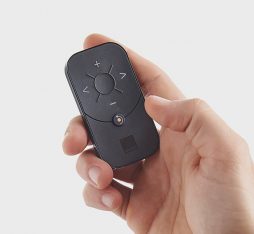• Adoption of the new technology has required the development of standards for interoperability, upgrades to network infrastructure and new security measures.
• Standardisation, interoperability and data sovereignty: overcoming obstacles and grasping opportunities with the deployment of eSIMs.
For Orange expert Yoann Noisette, the advent of eSIMs or embedded Subscriber Identification Modules will pave the way for “a wide-ranging transformation of connectivity.” The transition from physical SIM cards to identification chips integrated directly in devices will be a gamechanger in the telecoms ecosystem. Laurent Coureau, head of the SIM and eSIM department at Orange, adds: “This is not just about miniaturisation. The transition required a complete redesign of the entire connectivity life cycle, taking in everything from security to the user experience.”
Today’s eSIMs are more secure than conventional SIM cards, because they are integrated in chips that have been evaluated and certified.
Along with the traditional market, the travel market is booming. “We are seeing a lot of new arrivals like Orange Travel, which enable customers to set up eSIMs in compatible devices with only a few clicks, so that they can benefit from specific payment plans for trips to countries like the US or Madagascar,” points out Yoann Noisette. For Orange, this emerging market has substantial potential, “But given the number of new competitors entering the eSIM market, we will have to provide a flawless customer journey.”
Standardisation and architecture in a secure ecosystem
“Orange has played a crucial role in establishing strict standards defined by the GSMA,” points out Laurent Coureau, who notably chaired the eSIM Working Group for the association of telecommunications manufacturers and operators that developed common rules and specifications for eSIMs. “We worked in close collaboration with all partners to ensure that eSIMs are both secure and usable with any type of device, while providing customers with a simple and effective digital journey.” Today’s eSIMs are more secure than conventional SIM cards, “because they are integrated in chips that have been evaluated and certified,” adds Yoann Noisette. Mobile network operators will also have to guarantee that the transition to eSIMs does not compromise data sovereignty. “Given that servers are increasingly cloudified, we have to ensure that customer data remains protected in a strongly regulated jurisdiction such as France,” points out Laurent Coureau.
Technical challenges and solutions
Unlike conventional SIMs, eSIMs establish an open ecosystem that has a much larger attack surface. “We have developed tools like iAlerting to detect suspicious connections, and OTP (one-time password) systems to protect profile downloads,” explains Yoann Noisette. To ensure maximum confidence, “eSIM servers are certified by the GSMA and regularly audited to guarantee their integrity,” points out Laurent Coureau.
Interoperability is another major challenge. For the deployment of eSIMs, new methods for transferring profiles between devices had to be developed, for example to take charge of cases where a customer wishes to change phones. And they required significant investment in infrastructure. “Thanks to GSMA’s On-Device Service Activation (ODSA) protocol and solutions like Apple’s Quick Transfer, customers can switch devices without disrupting their network access,” explains Yoann Noisette. A further challenge is to adapt to developments in the customer experience instigated by OEMs (Original Equipment Manufacturers). The advent of eSIM-only devices, such as the iPhone 17 Air — which will likely be followed by the mass adoption of eSIMs — has obliged operators to provide support for new on-device experiences that assist users not only with the initial activation of subscriptions but also with subscription transfers from mobile to mobile. “As part of a global approach that is ideally suited to the needs of customers, operators will have to digitalize subscription processes and provide 24/7 support,” points out Laurent Coureau.
He further explains that they will also “have to fall in-step with the trend for ‘integrated SIMs (iSIMS), which is a commercial, but non-technical term used to describe eSIMs integrated directly into chipsets. Like regular eSIMs, iSIMs are not virtual software-only SIM cards, but they are different in as much as they are not housed like eSIMS in dedicated chips but integrated in processors such as Qualcomm’s high-end Snapdragon.” Manufacturers are keen to take advantage of greater miniaturization and cost optimization afforded by iSIMS. Mobile operators will not be much affected by their adoption; however, the technological shift will likely be disruptive for suppliers of eSIM software and hardware like Thalès and STM.
IoT and the international market
The transition to eSIMs will add considerable value in the field of IoT. “The deployment of eSIMs will facilitate management and updating for our clients with needs like automotive connectivity and remote meter reading,” points out Yoann Noisette. And these are just two opportunities in a host of possibilities that notably includes the use of eSIMs in industrial sensors.
In Poland, Orange is targeting a 100% digital market with its Flex application that enables the operator to distribute and activate eSIMs. “We have redesigned the entire customer journey from ‘Know Your Customer’ identity validation right up to the delivery of an eSIM profile,” explains Yoann Noisette. “It’s a model that we will be progressively deploying in other countries. With eSIMs, all the subsidiaries in the Orange Group have committed to simplifying and digitalizing customer journeys, as illustrated by such recent examples as the deployment of the Hello eSIM application in Luxembourg and Hello 5G, which made use of eSIMs to promote the Group’s 5G network in France.” In Africa, Orange is working with local partners to overcome technical and regulatory challenges. As Laurent Coureau concludes: “The goal is to extend the benefits of eSIMs to markets where infrastructure is less mature. Even if adoption is slower, they have enormous potential.”
Read more :
- Orange Travel & ALL Accor sign a global partnership agreement to offer all members of the ALL Accor program an international eSIM mobile connectivity solution
- Luxembourg: with the Hello eSIM application, users can easily activate an eSIM in Luxembourg or abroad, and benefit from near-local rates in more than 300 global destinations: Install your prepaid travel eSIM with 3 clicks: Hello eSIM | Orange Luxembourg
- France: The Hello 5G application allows users to test the quality of the No. 1 mobile network in mainland France for free and without obligation, with 20GB of mobile internet for 31 days: Orange Hello 5G: Free trial, advantages, easy and fast subscription! (In French)











